Future in Graphic designing
Graphic designing is a creative field that involves the visual communication of ideas and messages using various elements such as images, typography, colors, and layouts.
It is the art of combining aesthetics and functionality to create visually appealing designs for both print and digital media. Graphic designers use their skills to convey information, evoke emotions, and enhance user experiences through visual means. They play a vital role in shaping the way we perceive and interact with the world around us.
Graphic Design is one of the best career options due to the increase in Graphic Design professionals so taking a graphic design courses in Delhi from the best graphic design institute can be helpful to gain some knowledge and experience.
Importance of Graphic Designing in the Digital Age
In the digital age, graphic designing has gained tremendous importance due to its significant impact on various aspects of our lives. Below are some key reasons why graphic designing is crucial in the digital age:
Visual Communication: Graphic designing helps convey information and messages visually, making complex ideas easier to understand and engaging for the audience.
Branding and Identity: Graphic design plays a vital role in creating a consistent and recognizable brand identity, establishing trust and loyalty among customers.
User Experience (UX) Design: Graphic designers contribute to creating user-friendly and visually appealing interfaces for websites and digital platforms, ensuring a positive user experience.
Digital Marketing: Engaging visual content created by graphic designers attracts attention, conveys messages effectively, and drives conversions in digital marketing campaigns.
Web Design and Development: Graphic designers collaborate with web developers to create visually appealing websites that capture and retain user interest.
Social Media Presence: Graphic design is essential for creating visually appealing social media posts and graphics that help businesses connect with their audience and maintain a consistent visual identity.
Innovation and Creativity: Graphic design in the digital age allows for innovative and creative expression, leveraging new technologies and techniques to push boundaries and create captivating visual solutions.
Future Technologies Shaping Graphic Designing
Artificial Intelligence (AI) and Machine Learning (ML):
Artificial intelligence and machine learning are revolutionizing the field of graphic design. AI-powered tools can analyze data, identify patterns, and generate design recommendations.
Machine learning algorithms can automate repetitive tasks, such as resizing images or removing backgrounds, saving valuable time for designers. AI can also assist in generating personalized and dynamic content, such as customized advertisements based on user preferences. As AI continues to advance, it will play an increasingly significant role in streamlining design workflows and enhancing creative possibilities.
Virtual Reality (VR) and Augmented Reality (AR):
Virtual reality and augmented reality are transforming the way we experience and interact with visual content. In graphic designing, VR and AR technologies enable designers to create immersive and interactive experiences.
VR allows designers to showcase their work in a three-dimensional virtual environment, providing clients and stakeholders with a realistic preview of the final design. AR overlays virtual elements onto the real world, opening up possibilities for interactive product visualization, informative overlays, and engaging marketing experiences.
Graphic designers need to adapt their skills to design for these emerging technologies and leverage their capabilities to create captivating and impactful visual experiences.
3D Printing and Design:
The rise of 3D printing has opened up new horizons for graphic designers. 3D printing technology allows designers to bring their creations to life by transforming digital designs into physical objects.
This technology is particularly valuable for product design and prototyping, enabling designers to create intricate and complex models with ease.
Graphic designers can explore the realm of three-dimensional design, experiment with textures and materials, and create unique and tangible designs that were once limited to the digital realm. Understanding the principles of 3D design and mastering the tools and software associated with 3D printing will be essential for future graphic designers.
Internet of Things (IoT) Integration:
The Internet of Things (IoT) refers to the network of interconnected devices and objects that communicate and exchange data. Graphic designers will play a crucial role in designing user interfaces and visual elements for IoT devices.
These devices include smart home systems, wearables, and various other connected devices. Designing for IoT requires understanding user interactions, designing intuitive interfaces, and visualizing data in a meaningful and accessible way. Graphic designers need to adapt their skills to create seamless and visually appealing user experiences across a wide range of IoT devices.
Future Job Prospects in Graphic Designing
Demand for Graphic Designers in Various Industries:
In the future, there will be a high demand for graphic designers across various industries. Businesses rely on graphic designers to create visually appealing designs for their marketing, branding, and communication needs. Industries such as advertising, digital media, e-commerce, and publishing will continue to require the skills of graphic designers to effectively convey their messages and enhance their brand presence.
Emerging Design Roles and Specializations:
As technology advances, new design roles and specializations are emerging within the field of graphic design. Specializing in areas such as user experience (UX) design, user interface (UI) design, motion graphics, and data visualization will provide exciting career prospects.
UX/UI designers focus on creating intuitive and visually appealing interfaces for digital platforms, while motion graphics designers work on animations and videos. Data visualization specialists transform complex data into visually engaging visuals. By acquiring specialized skills in these emerging areas, graphic designers can explore unique job opportunities and stay competitive in the evolving market.
Freelancing and Remote Work Opportunities:
The future of work offers increased flexibility for graphic designers, including freelancing and remote work opportunities.
Many companies are embracing remote work models, allowing designers to work from anywhere. Freelancing provides the freedom to choose projects and work with a variety of clients and industries.
Remote work allows designers to collaborate with clients and teams worldwide. These options provide greater autonomy and flexibility in managing one's schedule and work environment, offering new avenues for career growth and work-life balance.
Conclusion:
The future of graphic design offers promising job prospects and opportunities for growth. The demand for graphic designers will continue to rise across various industries as businesses recognize the importance of visually appealing and effective design in the digital age.
To thrive in this evolving landscape, graphic designers should embrace emerging design roles and specializations, such as UX/UI design, motion graphics, and data visualization.
It is crucial to master essential design software and applications, possesses skills in user experience and user interface design, and be proficient in motion graphics and animation.
By continuously updating their skills and staying abreast of industry trends, future graphic designers can position themselves for success and contribute to the visually captivating and engaging world of design.





Comments
Post a Comment